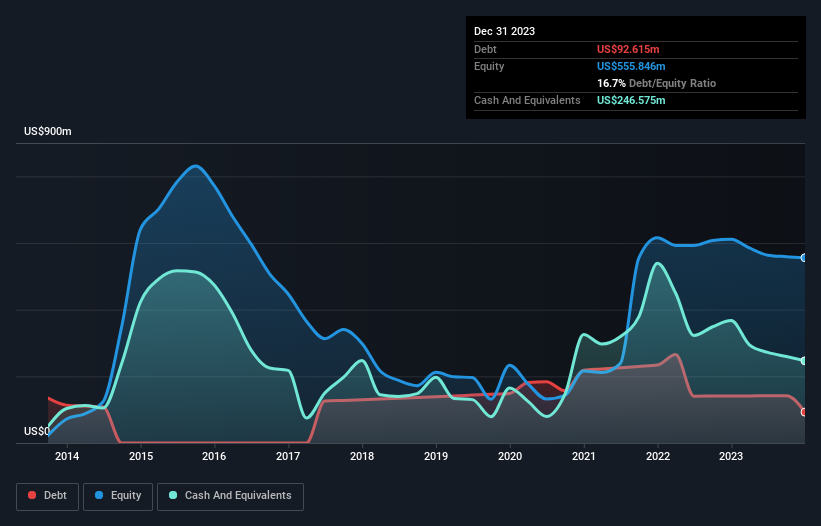David Iben put it well when he said, 'Volatility is not a risk we care about. What we care about is avoiding the permanent loss of capital.' So it might be obvious that you need to consider debt, when you think about how risky any given stock is, because too much debt can sink a company. Importantly, GoPro, Inc. (NASDAQ:GPRO) does carry debt. But the real question is whether this debt is making the company risky.
What Risk Does Debt Bring?
Debt assists a business until the business has trouble paying it off, either with new capital or with free cash flow. In the worst case scenario, a company can go bankrupt if it cannot pay its creditors. However, a more frequent (but still costly) occurrence is where a company must issue shares at bargain-basement prices, permanently diluting shareholders, just to shore up its balance sheet. Of course, the upside of debt is that it often represents cheap capital, especially when it replaces dilution in a company with the ability to reinvest at high rates of return. When we examine debt levels, we first consider both cash and debt levels, together.
View our latest analysis for GoPro
What Is GoPro's Debt?
As you can see below, GoPro had US$92.6m of debt at December 2023, down from US$141.0m a year prior. But it also has US$246.6m in cash to offset that, meaning it has US$154.0m net cash.

A Look At GoPro's Liabilities
According to the last reported balance sheet, GoPro had liabilities of US$279.1m due within 12 months, and liabilities of US$133.0m due beyond 12 months. Offsetting these obligations, it had cash of US$246.6m as well as receivables valued at US$91.5m due within 12 months. So it has liabilities totalling US$74.1m more than its cash and near-term receivables, combined.
Given GoPro has a market capitalization of US$440.9m, it's hard to believe these liabilities pose much threat. However, we do think it is worth keeping an eye on its balance sheet strength, as it may change over time. While it does have liabilities worth noting, GoPro also has more cash than debt, so we're pretty confident it can manage its debt safely. There's no doubt that we learn most about debt from the balance sheet. But ultimately the future profitability of the business will decide if GoPro can strengthen its balance sheet over time. So if you want to see what the professionals think, you might find this free report on analyst profit forecasts to be interesting.
In the last year GoPro had a loss before interest and tax, and actually shrunk its revenue by 8.1%, to US$1.0b. That's not what we would hope to see.
So How Risky Is GoPro?
Statistically speaking companies that lose money are riskier than those that make money. And we do note that GoPro had an earnings before interest and tax (EBIT) loss, over the last year. And over the same period it saw negative free cash outflow of US$34m and booked a US$53m accounting loss. With only US$154.0m on the balance sheet, it would appear that its going to need to raise capital again soon. Overall, we'd say the stock is a bit risky, and we're usually very cautious until we see positive free cash flow. When analysing debt levels, the balance sheet is the obvious place to start. However, not all investment risk resides within the balance sheet - far from it. To that end, you should be aware of the 1 warning sign we've spotted with GoPro .
At the end of the day, it's often better to focus on companies that are free from net debt. You can access our special list of such companies (all with a track record of profit growth). It's free.
New: Manage All Your Stock Portfolios in One Place
We've created the ultimate portfolio companion for stock investors, and it's free.
• Connect an unlimited number of Portfolios and see your total in one currency
• Be alerted to new Warning Signs or Risks via email or mobile
• Track the Fair Value of your stocks
Have feedback on this article? Concerned about the content? Get in touch with us directly. Alternatively, email editorial-team (at) simplywallst.com.
This article by Simply Wall St is general in nature. We provide commentary based on historical data and analyst forecasts only using an unbiased methodology and our articles are not intended to be financial advice. It does not constitute a recommendation to buy or sell any stock, and does not take account of your objectives, or your financial situation. We aim to bring you long-term focused analysis driven by fundamental data. Note that our analysis may not factor in the latest price-sensitive company announcements or qualitative material. Simply Wall St has no position in any stocks mentioned.
About NasdaqGS:GPRO
GoPro
Provides cameras, mountable and wearable accessories, and subscription and services in the Americas, Europe, the Middle East, Africa, and the Asia Pacific.
Adequate balance sheet and fair value.
Similar Companies
Market Insights
Community Narratives



